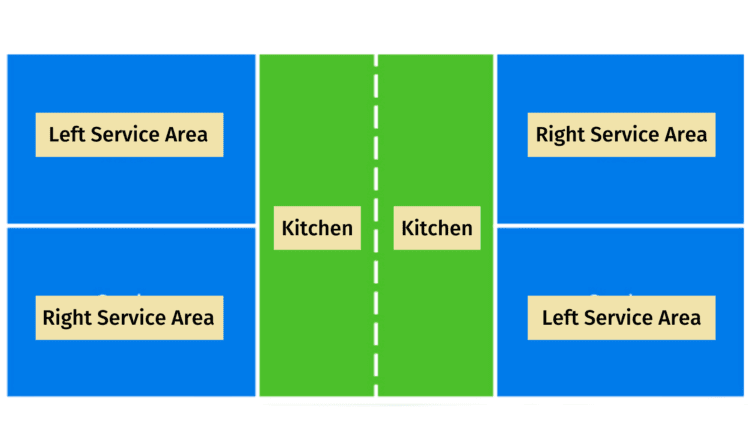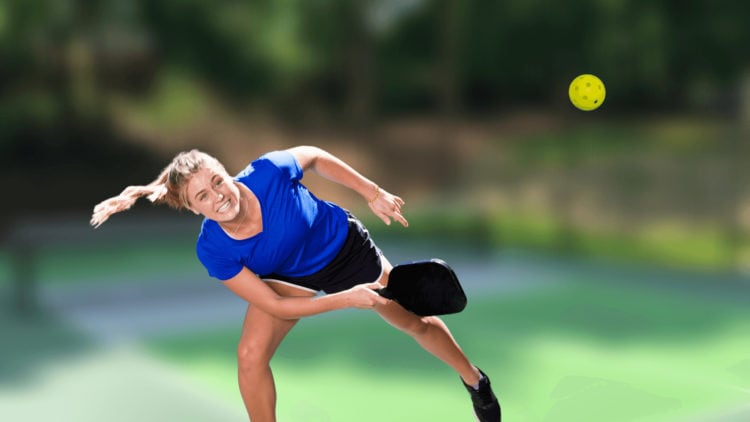
OBJECTIVE OF PICKLEBALL: Be the first team to score 11 points by hitting the ball over the net with your paddle.
NUMBER OF PLAYERS: 2 or 4 players, 1 or 2 on each team
MATERIALS: 1 pickleball paddle per player, 1 pickleball, 1 pickleball net
TYPE OF GAME: Sport
AUDIENCE: All ages
OVERVIEW OF PICKLEBALL
Pickleball is a fun, fast-paced sport that seamlessly blends elements and rules of tennis, badminton, and ping pong. A relatively young game, pickleball came to be in the mid-1960s, thanks to Joel Pritchard and Bill Bell. According to legend, pickleball got its name from Pritchard’s dog, Pickles, who would chase after the ball. Today, pickleball is not only a recreational favorite but a fiercely competitive sport with a rapidly growing community. In fact, pickleball is now the fastest-growing sport in the United States, with participation growing by 171.1% in just 4 years!
What’s great about pickleball is its accessibility. It’s a relatively simple sport that is easy to pick up, contributing to its explosive growth, especially among seniors and those seeking a less physically demanding alternative to traditional racquet sports. Around the world, pickleball is played both recreationally and competitively, with tournaments ranging from local community events to even international championships!
SETUP

Before we get into the rules, it’s important to know what a pickleball court looks like.
The pickleball court measures 20-foot by 44-foot split in half with a net that goes across the width of the court. On either side of the net is a 7-foot wide non-volley zone or “Kitchen”. Players are not able to hit the ball from the Kitchen.
On each half of the court behind the Kitchen are two adjacent 15-foot by 10-foot sections called the service court. The right service court on each side is the even side, and the left side is the odd side.
EQUIPMENT
To play pickleball, you’ll also need the proper equipment. Each player will need a pickleball paddle. If you’re after the right pickleball paddle for you, check out our list of the 10 best pickleball paddles! To play pickleball, you’ll also need a pickleball to rally back and forth.
In terms of what to wear, there’s no official pickleball uniform, so you can wear whatever you feel comfortable in! With that said, some clubs have adopted tennis dress codes. So, you can simply wear shorts and a t-shirt, if that’s what’s comfortable for you. The important thing is: Make sure you get the right shoes. Wear tennis shoes, sturdy shoes with good traction; do not wear running shoes.
GAMEPLAY

Pickleball is generally a doubles game, but you can also play it 1 vs 1 (more on this below!). Many liken this game to tennis but with a smaller court and a few different rules. Similarly to tennis, one team serves the ball, and the other attempts to return the ball back to the other team without hitting it out of bounds or faulting.
A pickleball game starts with one team serving and the other team receiving. Before serving, the server will announce the score as follows:
Their team’s score – the other team’s score – the number of the server (for doubles only), which would generally start as 0-0-1.
PICKLEBALL SERVING RULES
Each player on a pickleball team gets a chance to serve before the other team serves. The serving always starts on the right side of the court and changes to the left side after a fault. The server must stand behind the back line when serving, and they must serve the ball underhand. And the paddle contact must be made underneath the waist level of the player. The server should hit the ball diagonally from their side of the court, over the net, past the Kitchen, and into the opposite quadrant of the court. There is only one service attempt per server.
Every time a server score a point, the server switches sides to serve again. So, if the server served from the right side the last serve, they will serve from the left side if they win a point.
When the team makes a fault, the second server on the same team gets a chance to be the server if they haven’t yet served. However, the only exception to this rule is the beginning of a new game, when only one player from each team can serve before faulting a second time. After this, service will automatically pass to the receiving team. This is to prevent creating an unfair advantage.
SCORING
Only the serving team can score points in pickleball – whenever the non-serving team makes a fault. If the serving team makes a fault, the result is either switching servers or a side out. A side out is when the receiving team now gets a chance to serve.
For example, the score is 1-1-1, meaning both teams have 1 point and the first server on a team is serving. The server hits the ball and the opposing team returns it but hits it into the net. The serving team scores a point, and now the score is 2-1-1. On the next serve, the server hits the ball into the Kitchen, which is a fault on the serving team. The serving team switches servers, so the score is now 2-1-2. If the second server on the serving team makes a fault, the opposing team then serves, and the score becoming 1-2-2.
Generally, most pickleball games are played to 11 points, with a 2-point difference, but some tournament games may play up to 15 or even 21 points.
When the serving team score is even, the team’s first server in the game will be in the right side of the court when serving or receiving. However, when the serving team’s score is odd, that player will be on the left side.
DOUBLE BOUNCE RULE
After the serve, the receiving team must allow the ball to bounce on their side once before returning it. The serving team must then allow the ball to bounce once on their side before returning as well. After the ball has bounced once on both sides, the players can then either volley the ball without letting the ball bounce first or allow the ball to bounce and then return it.
The double bounce rule in pickleball gets rid of the serve-and-volley advantage and allows for a more even playing field and better rallies!
THE PICKLEBALL KITCHEN RULES
If you’ve ever been to a pickleball match, one of the most entertaining moments is when a player steps into the Kitchen before the ball bounces, and the entire court yells, “Kitchen,” which is a fault.
While Kitchen isn’t the technical term (that would be non-volley zone), this area of the court is integral to the pickleball match. In the simplest terms, you cannot step inside the Kitchen to volley. In other words, the ball must bounce first before you can enter the Kitchen.
The main rule of the Kitchen in pickleball: don’t stand in or even put a single toe in the Kitchen zone or line while volleying a ball. And yes, this includes the initiation of a volley and your momentum after hitting a volley. Anything that is a part of you cannot touch or pass into the Kitchen. You should also stay away from the Kitchen after you hit the volley.
Another rule you should keep in mind is that you cannot violate the intent of the Kitchen rule. This goes back to the fact that you can’t initiate a volley from the Kitchen. If a player touches the Kitchen at any point, both of their feet must completely leave the Kitchen before being able to volley the ball. So, basically, you can’t stand in the Kitchen, jump to volley, and land outside the non-volley zone.
Now that you know what you can’t do in the Kitchen, what can you do? Everything else! As long as it’s not a volley, you are free to hit the ball from the Kitchen. But in terms of strategy, it’s not generally a smart thing to do to camp out in the Kitchen at any rate, as you may accidentally reach for a volley while in the Kitchen.
LINE CALLS
If a ball on a serve contacts a line, it’s considered “in.” The only exception to this is the Kitchen line. If a serve contacts the Kitchen line, it is short and a fault.
FAULTS
A fault occurs when a player breaks a rule of the game. A fault either results in a point for the serving team or a side-out. Here are the plays that are considered faults according to pickleball rules:
- A player volleys the ball while standing in the non-volley zone.
- A player hits the ball out of bounds.
- A player hits the ball into the net.
- A player volleys the ball before it has bounced on both sides.
- A player, their clothing, or paddle touches the net or net post while the ball is in play.
- The serve does not clear the non-volley zone.
- A serve doesn’t land within the receiving court lines.
- The receiver hits the ball after it bounces twice.
- Violation of a service rule.
- A ball in play hits an object before bouncing back on the court.
- A ball in play hits a player or their clothing.
PICKLEBALL DOUBLES VS SINGLES RULES

As you know, you can play pickleball as doubles or singles, but do they differ in rules?
Of course, while there are some tactics you can still bring into singles pickleball matches from doubles, the singles match puts more emphasis on each player, as each player will have to cover the whole 20-foot court. So, the sheer amount of physical effort required in pickleball singles matches would be the biggest difference between doubles and singles.
Besides that, almost all of the rules for singles pickleball are the same as those for doubles pickleball. There are only two differences:
- Serving Sequence: In singles, the serving player alternates sides if they win a point, but if they lose the rally, they side out, and the serve goes straight to the opposing player.
- Scoring: In singles, you keep track of scores like this: 0-0, instead of 0-0-0. The first number is the serving player’s score, while the second is the receiver.
PICKLEBALL SKINNY SINGLES
There’s a reason pickleball is generally a doubles match rather than a singles match. It’s simply too hard to cover the entire court alone. To combat this problem, many pickleball singles players will opt to play skinny singles. Pickleball skinny singles is great for many reasons, including:
- It equalizes the playing field.
- You can work on your angles and dinks.
- You can work on your shots.
- You can work on your paddle skills.
- You will improve accuracy and placement
- And best of all, there’s less running!
To play pickleball skinny singles, the length of the court will be the same as normal pickleball matches, but it will be half the width. You can either play on one side, essentially cutting the court in half down the line that separates the court into right and left, or you can play diagonally, with each player on the right or left area of their side of the court.
Serving will be the same, done from the backline, but you’ll either be hitting the ball directly in front of you or cross-court, depending on how you decide to set up the skinny court.
And since the court will be half the width, players must be much more strategic with their shots. Angles and placements matter all the more with pickleball skinny singles!
PICKLEBALL STRATEGY
As with any sport, strategy is an important part of pickleball. Pickleball is not just a physical game but also a mental one, so it’s crucial to have a smart game plan. The strategies you employ will involve tricks, tactics, and tips – all designed to help you win a game and match!
- Master the dink: The dink is a soft and controlled shot played close to the net. Use the dink to battle at the net, forcing your opponents into errors or creating opportunities for an offensive shot. Patience is key here; wait for the right moment to execute a well-placed dink.
- Keep the pickleball low: While this may be difficult, a strategy to employ is to keep the pickleball low while still getting the ball over the net. A low pickleball will make it more difficult for the opposing team to hit an aggressive shot. Generally, with a low ball, your opponents are more likely to hit a drop shot than a drive, which may lead to a dink!
- Keep opponents away from the Kitchen: Since the Kitchen is a prime scoring position, do all you can top keep the opponents away from the kitchen line! Instead, try to move them further back in the court, and if they get too close, lob a shot over their head to force them back. The last thing you want is for them to hit an overhead smash!
- Communicate: For doubles pickleball, it’s incredibly important that you communicate with your partner! Communicate during a rally and between shots.
- Play to your strengths: Of course, with any sport, you should play to your strengths. If you have a great dinking game, try to slow down the pickleball. And if you have a good lob, lob your opponents! In the same vein, you should try to figure out the opposing team’s weaknesses and exploit them.
- Be patient: Be patient and focus on making consistent and controlled shots. Wait for the right moment to strike. Read the game, assess your opponent’s weaknesses, and wait for the perfect opening!
BEST PICKLEBALL PLAYERS
As the fastest-growing sport in the United States, saying interest has grown in pickleball is a bit of an understatement. However, with growing interest in this sport comes the want to know the best pickleball players in the world. This is by no means a comprehensive list, but these are some of the best pickleball players in the world – so you know exactly who to admire and aspire to!
- Ben Johns: Ben Johns is an absolute beast in pickleball for men’s singles and men’s and mixed doubles pickleball. He recently ended a 108-match winning streak for singles pickleball!
- Tyson McGuffin: McGuffin boasts multiple Grand Slam titles and is a four-time National Champion.
- JW Johnson: “Just Win” Johnson has multiple winning titles in men’s singles, men’s doubles, and mixed doubles.
- Zane Navratil: Navratil made the transition from tennis and is ranked as one of the best pickleball players in the world, boasting over 80 medals.
- Anna Leigh Waters: Number one in women’s singles and doubles as well as mixed doubles (teamed with Ben Johns), Waters is a force to be reckoned with.
- Catherine Paranteau: Once a top-ranked tennis player, Paranteau is now ranked number 2 in women’s pickleball.
Check out Johns and McGuffin’s 2023 Hertz Gold Cup final match for gold:
END OF GAME
A pickleball game is played to 11 points, but the winning team must win by at least 2. So, if the score is 11-10-1, the winning team must score another point to win. Pickleball matches are usually played in a set of best out of 3. In some cases, the third game is played to 15 points instead of 11. Other tournament games may be to 21 points as well!
FAQ
Can You Enter the Kitchen Before the Ball Bounces in Pickleball?
Pickleball rules state that the only thing you can’t do in the Kitchen is volley the ball. So, yes, you can enter the Kitchen, but it has to be before you hit the ball. You can only hit the ball while in the Kitchen after the ball bounces. Otherwise, you’ll need to make sure both of your feet are outside of the Kitchen.
Can You Hit a Pickleball Twice?
Technically, yes, you can hit a pickleball twice, but there are some caveats. For the double hit to be legal, the hit must be by a single player in an unintentional, continuous, single-direction stroke.
Can You Serve Overhand in Pickleball?
No, you cannot. You can only serve underhand or drop serve. But after the serve, once you have hit the ball underhand, you can then hit the ball overhand.
Is Pickleball a Difficult Sport?
Pickleball is often compared to ping pong for its similar rules and simplicity. It’s a relatively easy sport to follow and learn how to play for beginners. Mastering the sport, of course, is a whole other story!
- 200+ INSANE “KISS MARRY KILL” QUESTIONS TO ASK - April 16, 2024
- 15 BOARD GAMES FOR 5 YEAR OLDS (THAT EVEN YOU WILL ENJOY) - November 10, 2023
- 21 BACHELORETTE PARTY GAMES THAT EVERYONE IS GUARANTEED TO LOVE - December 13, 2022